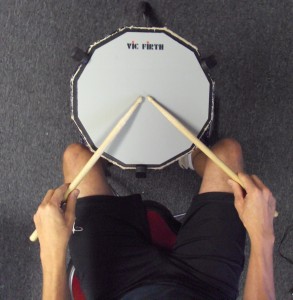
Here are some basic pointers to steer you clear of mistakes most people make with drumming technique. The full discussion with plenty of pictures, is found in the book, “Play Drums Now 2.1: Sport / Rudiments”. Read More About This Book
Your instincts are probably wrong!
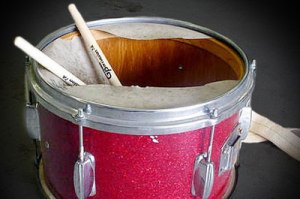
Learning correct drumming technique is vitally important! What you are born with and how your body wants to move instinctively are not usually the best qualities for drumming. As an instructor I have seen that most people begin with tendencies that have to be reshaped into ideal drumming habits, if they want to gain skill on the drumset. Proper drumming technique often goes counter to what feels natural!
For example, here are some of the tendencies that feel natural at first that you don’t want to hang on to (watch out for these!):
Typical Bad Drumming Habits
- Keeping elbows out from sides of body- your body usually does this for leverage, but in the case of drumming it will make your shoulders and neck stay tight for long periods of time.
- Flaring out pinky fingers and/or other nearby fingers- this is an instinctive mechanism used for various purposes when you need those certain fingers out of the way of what you’re trying to do. When drumming, this keeps your hand muscles too tense- you should keep your fingers pointed down and relaxed when you need them out of the way, not sticking out like wings.
- Keeping shoulders raised- often your body does this when you are in an ‘athletic-ready’ position, so you can use your arm strength at any moment. For drumming, you will have more control if you’re more relaxed overall. Get used to letting your shoulders hang, because you only really need the action of your forearms to control your drumming.
- Playing the drums from your elbows- Before your wrists build the necessary prowess and control, your body will automatically use the motions it’s used to, that have more strength, such as the movement that throws a ball. You need to build up enough strength and familiarity in your wrist movements so that your body automatically uses these movements for control, instead of your arms.
What is technique? Becoming one with your equipment

Every sport, art, and activity in general has an ideal technique suited to it. This is because humans seek efficient ways to do things. Good technique produces the most results for the least effort.
Players of golf, baseball, soccer and any other sport know that there is a right and wrong way to use the ball. For drummers, good or bad technique affects speed, control, and agility.
Jojo Mayer said something memorable about technique “sand in the gears…” It reduces excess movement.
In great technique there are two main components: correct movements / positioning, and correct muscle strength. You must know your equipment, so that you can work with it: since technique is about efficiency, you are basically trying to have a symbiotic relationship with your equipment – you are actually engaging in a sort of dance, to make your equipment become like an extension of your body.
Really, you’re trying to make your body plus your equipment work together as one unit, responding as a perfect machine that obeys the signals from your mind and creativity. You want to basically ‘eliminate the middle man’ from the equation, so your ideas become sounds on the drumset instantly and with no distortion or interference.
Details Of Good Drumming Technique
Since most people aren’t used to these movements before drumming, it is helpful to practice them as much as possible, so that they quickly feel natural and you won’t be tempted to play any other way.
Stick grip
The drumsticks are designed to bounce easily, when held at the ‘sweet spot’ – the natural fulcrum that has very little vibration when the stick impacts your playing surface. It is usually about a third of the way up the stick from the bottom, and should be held between your thumb and forefinger. Wrap the rest of your hand loosely around the stick, so the stick crosses your hand at an angle.
Now, make sure to stay relatively loose with your grip, while playing. Pay attention to whatever vibration you can feel in the stick, to learn what it wants to do and how it wants to move.
Positioning
This is the most vital part of your technique. It will determine how efficient your movements will be.
Make sure you are sitting at the proper height so your hips are above your knees slightly. Position your feet on the pedals so that your ankles are further from you than your knees.
Now, relax your shoulders while sitting up straight, and keep your head balanced on your spine. Let your arms hang down asleep at your sides, then pretend strings are attached to your wrists and lift them up into a ‘bike-riding’ position. Your elbows should remain hanging at your sides while this happens. Position your wrists about 4-6″ above your playing surface, and about a stick-distance (16″) away from each other horizontally.
Make sure your hands are aligned straight with your arms at all time, so the wrist joint isn’t bent sideways. The easiest way to monitor this is to keep your middle knuckle in line with your arm. This will help you play smoothly and faster with your sticks.
Pedals
Keep the ball of your foot on the pedal board at all times. You can play with your heel up or down, but your ankle should always be in control of your movements, not your leg. The easiest way to train yourself for this is to play with your heels down, until you are comfortable doing so.
Also, since you don’t have control of the backswing of the beater (the spring does), it is helpful to try to leave the beater about an inch from the bass drum head after every stroke. This way, the spring is tight and ready to create a strong backswing.
More details…
Find more details about this topic in the book, “Play Drums Now 2.1: Sport / Rudiments”. The information I’ve presented there was compiled through much research over many years as a professional drum instructor. It will lead to your most efficient playing abilities!
Conditioning is required to create new technique
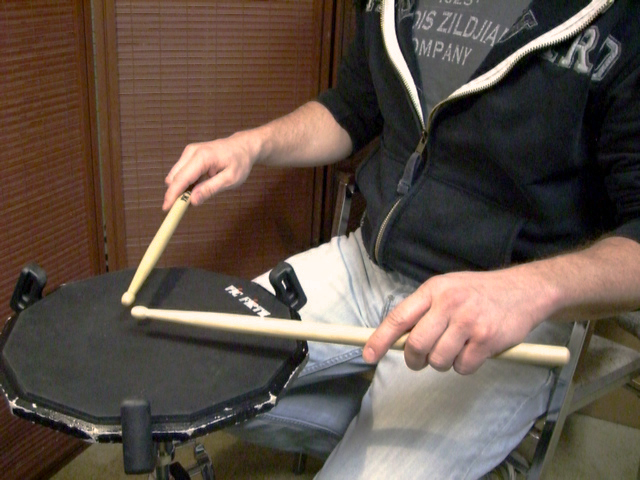
Creating this machine takes conditioning. It’s what every athlete and artist has to go through, to bring their equipment under perfect control. It’s very important, and it’s the only way to be completely in the zone, where you can just BE in the experience of playing drums, without having to be super deliberate about everything you’re doing.

Conditioning is like backwards computer programming- basically instead of rewriting the actual program that causes your movements and skill, you are repeating the ideal movements and positioning until your brain and body get used to them and the program slowly adjusts permanently.
How to absorb new programs for your mind / body
Feel the movements as you teach them to yourself, because it will help you absorb the new programs more quickly. Do not make mistakes, because they count as programming too… they will cause you to lose progress with your conditioning.
Technique Practice Tips:
- Carefully sculpt each position / freeze-frame of your movements
- Design your movements to be as efficient and smooth as possible
- Imagine the perfect movements on video, slowed down: imitate that like an actor on stage.
- Pay attention to how your equipment ‘wants’ to move, and let it move that way: force your body to learn to follow its lead
- Learn the RIGHT TECHNIQUE EARLY ON in your drumming career. Don’t guess, this is very important (see a drum instructor if necessary)!
Drumming Workouts

Part of good technique is having the appropriate levels of strength in the correct muscles. Often non-drummers do not have enough wrist or ankle strength until they have conditioned their strength and speed.
Workouts are a very important initiation into the world of drumming, so that you aren’t fighting your own limits while trying to develop the correct habits.
The topic of drumming technique in the PLAY DRUMS NOW program includes EVERYTHING YOU NEED. It was made to be complete and comprehensive, to the topic of physical drumset technique:
(Correct posture and positioning, equipment ergonomics and positioning, drumstick physics and control methods, pedal physics and control methods, arm movements, important basic workouts for strength and speed, and stretching routines.)
How to hit your equipment
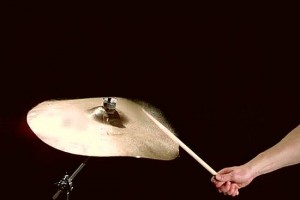
Another element of good drumming technique is making sure you connect the drumsticks to the drumset in the proper way. this means, first of all, use sticks with a clean (undamaged) tip/bead. If the bead has been chipped and has a ‘corner’ or ridge on it, it could dent the head. Also sticks must be the proper size for drumset equipment – don’t use marching sticks on a drumset, they are too heavy and will damage the heads and cymbals rather than rebounding properly. Same goes for bass drum and gong mallets, sledgehammers, golf clubs, and anything else ending in -club or -hammer.
Also, strike the drums straight on for the best sound and rebound, and strike the cymbals at a slight angle when crashing them.
What’s the difference between crashing and riding a cymbal?
Both are techniques as well as names of cymbals designed for each purpose.
Overview of correct drumming technique
Essentially, if I were to sum up the best technique on the drumset, it would take the form of this advice: 1) set up your seat height, snare position, and pedal placement before setting up any other parts of your drumset, 2) use your wrist and ankle movements rather than your arm and leg movements, 3) stay stable and sitting up straight but as relaxed as possible, 4) operate your wrist joint through a large range while keeping it roughly centered in the horizontal and vertical ranges, 5) hold the sticks at the fulcrum, pinched between your thumb and index fingers, 6) keep the ball of your foot (if not your entire foot) in contact with the pedal boards at all times, 7) train yourself with heels-down technique to develop ankle strength, and 8) work hard to train your body to be an ideal drumming machine.
Final Thoughts
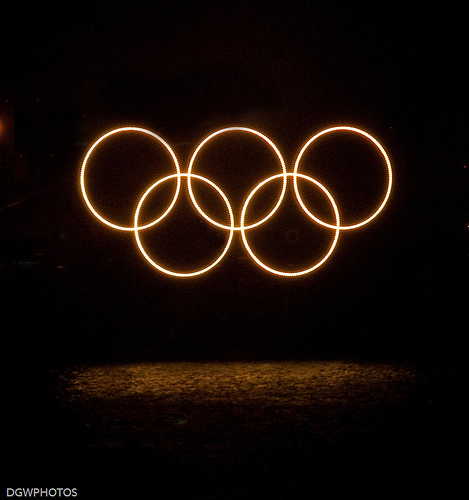
Another thing to keep in mind is that it helps your technique to be generally in shape: the body works as a unified system, so it will perform at a higher level if you are physically inclined in general and stay physically fit and healthy. Call it cross training, or whatever you want- but I would recommend a lifestyle involving some aerobic exercise, stretching, and strength training, ideally.

Another topic is overtraining. In order to get your default movement habits not only set to the right muscle groups but also relaxed and in control, the magic ingredient is MORE THAN ENOUGH STRENGTH.
When certain key principles are followed, you are free to develop whatever specific technique works for you and your unique body.
